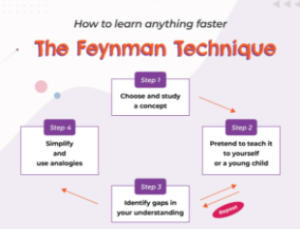“Tell me and I forget, teach me and I may remember, involve me and I learn.”
– Benjamin Franklin
In terms of studying g, you can readily relate to the preceding quote.
You give yourself a tool to utilise for the rest of your life when you truly learn something.
Because most new things will connect to something you already understand, the more you know, the fewer surprises you will experience.
The goal of education is to get a better understanding of the world.
However, the majority of us do not make an effort to learn anything on purpose.
As we progress through school, we memorise what we need to know, then forget the majority of it.
We don’t extrapolate from our experiences to widen the applicability of our knowledge as we go through life.
As a result, life repeatedly kicks us in the shins.
The Feynman Technique may be the best approach to study almost anything if you’re looking for a way to supercharge your learning and get smarter.
It was created by a Nobel Prize-winning physicist and uses the power of education to improve learning.
The Feynman Learning Technique is a straightforward strategy for learning anything new.
Why would you want to utilise it?
Because learning isn’t accomplished by reading through a book or memorising enough to pass a test.
When you can explain something and use it in a variety of settings, you’ve learnt it.
Instead of reducing anything new into isolated, meaningless factoids, the Feynman Technique gets more mileage out of the concepts you encounter.
Richard Feynman, a pioneer in quantum computing and nanotechnology who was regarded as the “Great Explainer” for his enthralling lectures at Cornell and Caltech.
Despite the fact that the British publication Physics World declared Feynman one of the top ten physicists of all time, he considered himself “an ordinary person who studied hard.”
The way Richard Feynman identified the things he didn’t know and then poured himself into studying them is what made him such a remarkable man.
Feynman provided insight into how he broke down the most complicated things in his profession and reduced them into simple chunks of knowledge that anyone could grasp over a long period of time.
These discoveries have been compiled and polished into “The Feynman Technique,” as it is now known.
The phase of simplifying is crucial to the Feynman Technique’s effectiveness.
Feynman famously recognised that he couldn’t teach the issue at an undergraduate level when preparing for his upcoming undergraduate lectures at Caltech.
Feynman realised at that point that he didn’t fully comprehend the subject if he couldn’t communicate it to a class of freshmen.
This prompted him to entirely rewrite the topic until he had streamlined his explanation and established parallels suitable for college students, resulting in a stronger understanding of the subject.
The Feynman Technique helps you turn information into knowledge that you can access as quickly as a button on your shirt to prevent the anguish of being befuddled by the unexpected.

Step 1: Pick a concept to study.
Choosing a study topic forces you to confront what you don’t know head-on.
Take out a blank sheet of paper or a fresh Word document once you’ve decided on a theme.
It should be titled with the topic’s name.
Then jot down anything you’d like to know about the subject.
Understanding how it works, how to use it to analyses, and when it should be applied to analyses are all examples of this.
Try to jot down everything you already know about the subject at this stage.
Don’t look for information on the internet to begin started.
An effective learning experience is based on the use of one’s own brainpower.
This is also the stage at which you should strive to understand the new notion by applying previous knowledge.
Make a mental note of any time you need to use a big, complicated word to explain something, and then ask yourself if you know what it means.
If you do, that’s fantastic!
If not, break down what the word implies and then try to come up with a simple method to express the process.
Step 2: Teach yourself or someone else how to do it.
This is the crucial step that determines how well you comprehend the subject.
It’s difficult to fool yourself into thinking you’re an expert on the subject if you teach it to yourself or, better yet, someone else.
Teaching yourself or someone else the topic will force you to refine and simplify your explanation to the point where even a 10-year-old could understand it.
Teaching creates a feedback loop in which inquiries and criticisms assist you to improve your knowledge of the subject.
Welcome questions, and if you don’t know the answer, write it down.
This is a fantastic approach to detect any knowledge gaps you may have.
The benefit of teaching yourself or someone else about a subject is that it boosts your confidence.
When this happens, you’ll be more willing to tackle more difficult topics and have the confidence to put what you’ve learned into practice in the future.
Step 3: Identify any gaps in your knowledge and go back to the original material.
This stage is part of an iterative process that also includes Step 2.
When you initially try to explain a subject to yourself or someone else, you will almost always discover knowledge gaps.
When this happens, you’ll need to go back to the source material to answer questions, clarify your understanding, and cement your knowledge.
Keep writing down your comprehension on the sheet of paper you started within the previous stage, and use plain language when adding additional crucial elements.
You can go back and teach the idea again if you’ve gained a new or deeper knowledge of it.
This cycle should be repeated as many times as necessary until you have a thorough understanding of the subject.
Step 4: Make your explanation as simple as possible.
The final step is to simplify your explanation or understanding of the subject until you can convey it without using jargon.
Jargon is frequently employed when people don’t understand what they’re talking about, either because it’s a quick way to describe a topic without exerting any effort, or because they simply want to appear knowledgeable.
As a result, this is the most crucial step in the procedure.
You can’t hide behind huge fancy words if you force yourself to express the topic in plain language.
Instead, it forces you to break down the subject into digestible chunks that anyone can understand.

Bottom Line:
It is priceless to have knowledge.
The more you know about how things function, the more options you’ll have for coping with the unexpected, and the better you’ll be able to generate and seize opportunities.
The Feynman Learning Technique is an excellent way for mastering large amounts of data.
Once you’ve done that, you’ll have a tremendous tool at your disposal.
However, as Feynman demonstrated, being open and able to question your own and others’ expertise is how you improve.
Learning is a process.
We recommend reading Feynman’s books if you wish to learn more about his ideas and teachings.
After all, As Mahatma Gandhi says:
“Live as if you were to die tomorrow. Learn as if you were to live forever.”
-End-



